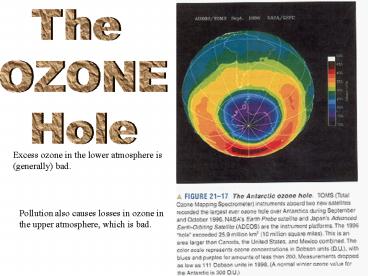Air Pollution - PowerPoint PPT Presentation
1 / 27
Title:
Air Pollution
Description:
... from salt spray and resides in the atmosphere for very short periods of time. ... 1985 - discovery of ozone hole ... and policing the end of all use will be ... – PowerPoint PPT presentation
Number of Views:45
Avg rating:3.0/5.0
Title: Air Pollution
1
The OZONE Hole
Excess ozone in the lower atmosphere is
(generally) bad.
Pollution also causes losses in ozone in the
upper atmosphere, which is bad.
2
Outer space
OZONE LAYER
30 miles
Good ozone Bad ozone
6 miles
Mt Everest, 8,848 m
Ground
3
(No Transcript)
4
(No Transcript)
5
Why holes over the poles?
Chlorofluorocarbons (CFCs)
6
Circumpolar winds transport air pollution from
heavily industrialized regions to the Arctic,
where high levels of smog accumulate.
7
Dobson unit 0.001mm at standard pressure and
temp 300 2 pennies thick, but solid O3 gas.
Instead, this gas is diffuse through
stratosphere (24 miles thick)
The British Antarctic Survey (BAS)
Jonathan Shanklin of BAS
8
(No Transcript)
9
CFC Production
10
(No Transcript)
11
The persistent ozone hole
12
(No Transcript)
13
(No Transcript)
14
How long does Chlorine remain in the atmosphere?
- Most of it hours to days.
- Most CL in atmosphere enters from salt spray and
resides in the atmosphere for very short periods
of time. - Chlorine transported to the upper atmosphere by
CFCs can remain for much longer 20-100 years!
15
Controlling OZONE destruction
1974 - Scientific study suggests theoretical
link between CFCs and ozone destruction 1985
- discovery of ozone hole 1985 - Vienna
Convention on Substances that Deplete the Ozone
Layer 1986 - DuPont begins research into HCFCs
1987 - U.S. bans use of CFCs in aerosols (US a
major manufacturer) 1987 - Montreal Protocol on
Substances that Deplete the Ozone Layer 1988 -
DuPont announces intention of stopping production
of CFCs 1988 - McDonalds switches away from
CFC-produced packaging 1988 - ozone losses 2 - 3
times as severe as predicted by models
locally up to 95 over Antarctica 1990 -
London Agreement (expands banned chemical list,
speeds up phase out) 1992 - severe ozone
depletion recorded in Northern Hemisphere 1992 -
Copenhagen Agreement (expands banned chemical
list, speeds up phase out) 1995 Venice amendment
(methyl bromide phaseout agreed upon) 2000
predicted Cl pool hits maximum and ozone begins
to recover
16
Controlling OZONE destruction
1. Each step since the Montreal Protocol
(London, Copenhagen, Venice) has been to further
limit and restrict ozone destroying
chemicals. 2. This has been made possible by a
technological solution (alternatives).
Black market CFCs continue and policing the end
of all use will be hard
17
Perhaps the single most successful international
agreement to date has been the Montreal Protocol.
"-Kofi Annan, Secretary General of the United
Nations
Summary of Montreal Protocol Control Measures
www.ozonehole.com
18
CFC Production
19
Methyl bromide
- Used to kill bacteria and insects on fruits and
vegetables. - Widely used
- A human health hazard (carcinogen)
- A ozone hazard
- Short atmospheric lifetime (lt 2 years)
- Very high capacity for damage (50 x CFCs)
- Br, like Cl, has a strong ionic bond potential
and strips electrons driving decomposition of O3
20
(No Transcript)
21
(No Transcript)
22
Who?
18th meeting in New Delhi
21 of 1991 baseline amount
EPA allocation
EPA
23
(No Transcript)
24
Greenhouse gases CO2, methane,...
25
(No Transcript)
26
(No Transcript)
27
What we know for certain
- The concentration of heat trapping gases in the
atmosphere is rising - The earths temperature is rising
- The scale of both is consistent with human caused
global warming






























